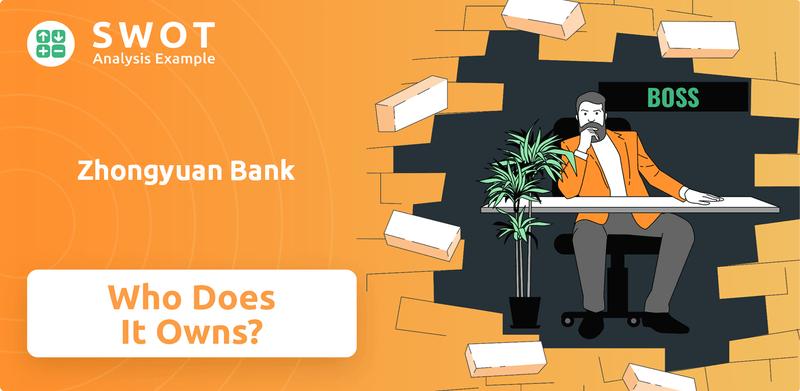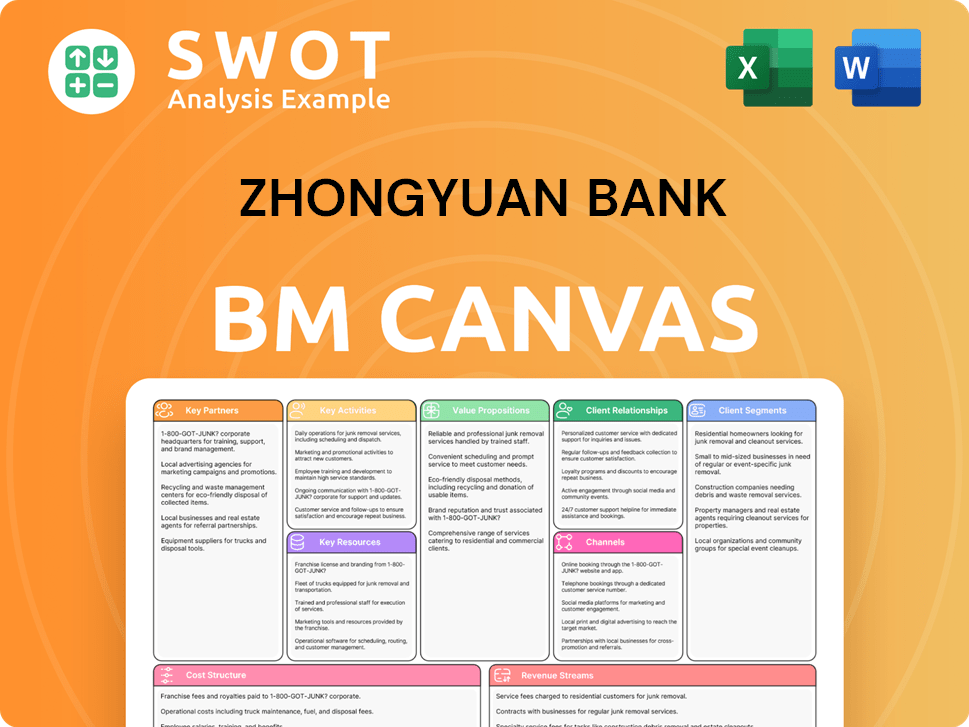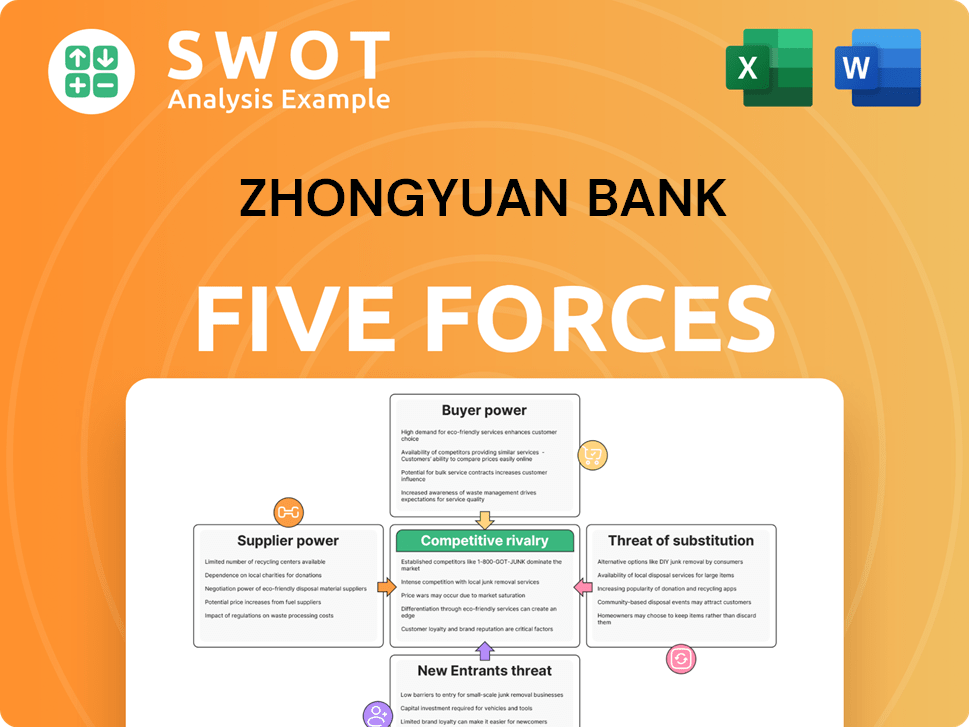Zhongyuan Bank Bundle
Who Really Owns Zhongyuan Bank?
Unraveling the ownership of a financial institution like Zhongyuan Bank is crucial for understanding its strategic direction and stability. In the dynamic landscape of Chinese banks, knowing who holds the reins provides vital insights into its governance and operational priorities. Established in late 2014, Zhongyuan Bank has grown to be a significant player, serving the Henan province and beyond.

Zhongyuan Bank's ownership structure, a blend of state-owned enterprises, institutional investors, and public shareholders, is a key factor in its operations. This Zhongyuan Bank SWOT Analysis can help you understand the bank's strengths and weaknesses. Understanding the nuances of Zhongyuan Bank ownership, from its parent company to its major investors, is essential for anyone evaluating its long-term prospects. This exploration will illuminate the bank's financial backing and the influence of its key stakeholders.
Who Founded Zhongyuan Bank?
The founding of Zhongyuan Bank, unlike many financial institutions, was not the result of a single entrepreneur or a small group of founders. Instead, it emerged from a strategic consolidation orchestrated by the Henan Provincial Government in December 2014. This initiative merged 13 existing city commercial and rural commercial banks within the province, creating a unified banking entity.
This unique structure means that the concept of traditional founders with an initial equity split is not applicable. The early ownership was distributed among the entities that contributed to the merger, mainly state-owned enterprises and local government-backed investment vehicles in Henan. The primary goal was to establish a stronger, more centralized banking presence to better serve the provincial economy.
The specifics of equity contributions and initial shareholding percentages from each of the 13 merging entities are not publicly detailed in the same way as a private company's seed funding round. However, it's widely understood that the Henan Provincial Government played a pivotal role in structuring this merger. This suggests that various provincial and municipal state-owned assets supervision and administration commissions, along with their investment arms, held significant stakes from the start. Early agreements focused on integrating assets, liabilities, and personnel from the merging banks rather than traditional vesting schedules or buy-sell clauses among individual founders. The founding vision was inherently aligned with regional economic development and financial stability, reflected in the consolidated control held by government-affiliated entities.
Zhongyuan Bank's ownership structure stems from a merger of 13 banks.
The Henan Provincial Government played a key role in the bank's founding.
Early ownership was distributed among merging entities, primarily state-owned enterprises.
The bank's vision was aligned with regional economic development.
Government-affiliated entities held consolidated control.
Early agreements focused on integrating assets and liabilities.
Understanding Zhongyuan Bank's growth strategy requires recognizing its unique ownership structure, which is heavily influenced by the Henan Provincial Government and its associated entities. The initial consolidation in 2014 involved merging several local banks, leading to a distributed ownership model rather than a traditional founder-led structure. The primary stakeholders are state-owned enterprises and local government-backed investment vehicles. This structure has implications for the bank's strategic direction and its alignment with regional economic development goals.
- Zhongyuan Bank ownership is primarily held by state-owned enterprises and local government-backed entities.
- The founding structure involved the merger of 13 banks, orchestrated by the Henan Provincial Government.
- The bank's focus is on serving the provincial economy and supporting financial stability.
- Early agreements prioritized the integration of assets, liabilities, and personnel.
Zhongyuan Bank SWOT Analysis
- Complete SWOT Breakdown
- Fully Customizable
- Editable in Excel & Word
- Professional Formatting
- Investor-Ready Format

How Has Zhongyuan Bank’s Ownership Changed Over Time?
The ownership of Zhongyuan Bank has seen significant changes since its establishment in 2014. A pivotal moment was its listing on the Main Board of the Hong Kong Stock Exchange on July 20, 2017. This initial public offering (IPO) allowed for a public float, broadening the shareholder base beyond the original provincial government-backed entities. The evolution of Zhongyuan Bank's ownership reflects its strategic growth and the trends within the Chinese financial sector.
As of late 2024 and early 2025, the major stakeholders of Zhongyuan Bank still include a strong presence of state-owned enterprises and government-related entities. For instance, Henan Investment Group Co., Ltd., a provincial state-owned enterprise, remains a significant shareholder. Other substantial shareholders include various municipal finance bureaus and state-owned asset management companies within Henan Province. While specific up-to-the-minute percentages for all major institutional investors can fluctuate, these government-backed entities collectively exert considerable influence.
| Ownership Milestone | Date | Impact |
|---|---|---|
| Formation | 2014 | Initial establishment with provincial government backing. |
| Hong Kong IPO | July 20, 2017 | Introduction of public float, diversifying shareholder base. |
| Ongoing | 2024-2025 | Continued significant ownership by state-owned enterprises and government-related entities. |
The bank's annual reports and public filings with the Hong Kong Stock Exchange, such as the fiscal year ending December 31, 2024, or interim reports for 2025, provide the most precise breakdown of current major shareholders. These reports would detail changes in shareholding over time, particularly any increases or decreases in stakes held by major state-owned or private entities. The continued substantial ownership by government-affiliated bodies suggests a strategic alignment with provincial economic goals, potentially impacting decisions regarding lending priorities, branch expansion, and support for local industries. This structure is typical of many Chinese banks, reflecting the influence of the state in the financial sector.
Zhongyuan Bank's ownership structure is characterized by a mix of state-owned and public shareholders.
- The IPO in 2017 was a key event, broadening the shareholder base.
- State-owned enterprises and government entities maintain significant influence.
- Annual reports provide the most detailed information on current shareholders.
- Understanding the ownership is crucial for assessing strategic direction.
Zhongyuan Bank PESTLE Analysis
- Covers All 6 PESTLE Categories
- No Research Needed – Save Hours of Work
- Built by Experts, Trusted by Consultants
- Instant Download, Ready to Use
- 100% Editable, Fully Customizable

Who Sits on Zhongyuan Bank’s Board?
The Board of Directors of Zhongyuan Bank, as of early to mid-2025, is structured to reflect its diverse ownership, particularly the significant influence of its state-owned major shareholders. The board typically includes executive directors, non-executive directors, and independent non-executive directors. The non-executive directors often represent the interests of major shareholders, especially those affiliated with the Henan Provincial Government and its investment arms. Individuals from entities like Henan Investment Group Co., Ltd. are likely to hold seats on the board, ensuring their strategic priorities are represented in the governance of the bank. This structure is common among Chinese banks, reflecting the influence of key stakeholders.
The composition of the board is crucial in understanding the bank's strategic direction and operational decisions. The presence of directors representing major shareholders ensures alignment with regional economic policies and stability objectives. This board structure is a key aspect of the bank's overall ownership and governance framework, reflecting the broader trends in the Chinese banking sector. The strategic decisions are heavily influenced by the directives and oversight provided by these dominant shareholders, ensuring the bank's alignment with regional economic policies.
| Board Role | Description | Representative Affiliations |
|---|---|---|
| Executive Directors | Responsible for day-to-day operations and management. | Senior management of Zhongyuan Bank. |
| Non-Executive Directors | Represent the interests of major shareholders and provide strategic oversight. | Henan Provincial Government, Henan Investment Group Co., Ltd. |
| Independent Non-Executive Directors | Provide independent oversight and ensure compliance. | Independent professionals with financial expertise. |
The voting structure of Zhongyuan Bank generally follows a one-share-one-vote principle for its publicly traded shares on the Hong Kong Stock Exchange. However, the concentration of shareholding among a few large, state-backed entities effectively grants them significant control. The volume of shares held by these major stakeholders provides them with considerable voting power in board elections and key strategic decisions. There have been no widely reported proxy battles or activist investor campaigns against Zhongyuan Bank in late 2024 or early 2025, which is common for banks with substantial state ownership in China. This structure ensures that the bank's operations align with regional economic policies and stability objectives.
The board of directors includes executive, non-executive, and independent non-executive directors, reflecting diverse ownership. Non-executive directors often represent major state-backed shareholders, such as the Henan Provincial Government. The voting structure generally follows a one-share-one-vote principle, but major shareholders wield significant influence.
- Board composition reflects state-backed ownership.
- Major shareholders have significant voting power.
- Strategic decisions align with regional economic policies.
- No recent proxy battles or activist campaigns.
Zhongyuan Bank Business Model Canvas
- Complete 9-Block Business Model Canvas
- Effortlessly Communicate Your Business Strategy
- Investor-Ready BMC Format
- 100% Editable and Customizable
- Clear and Structured Layout

What Recent Changes Have Shaped Zhongyuan Bank’s Ownership Landscape?
In the past few years, specifically from 2022 to early 2025, the ownership structure of Zhongyuan Bank has seen some shifts. These changes are influenced by the bank's performance and broader trends in the Chinese banking sector. While drastic changes like full privatization are uncommon, adjustments in shareholding have occurred. A notable example is the non-public issuance of A shares in early 2024. This brought in new investors, potentially diluting existing ones, while still maintaining the strong influence of state-owned entities. This issuance typically aims to bolster capital and strengthen the bank's financial standing.
Industry trends within Chinese banks emphasize financial stability and risk control. This often leads to strategic investments or divestments by state-backed entities. These actions support struggling regional banks or consolidate stronger ones. Although founder dilution isn't applicable to Zhongyuan Bank due to its merger-based origin, there's a general trend of increased institutional ownership. However, state and quasi-state entities often remain the dominant force. The bank's 2024 and 2025 reports may indicate ongoing efforts to optimize its capital structure and attract more institutional investors, even as its core ownership remains rooted in its provincial origins. Discussions about future ownership changes are typically communicated through annual reports or official announcements to the Hong Kong Stock Exchange.
| Year | Key Development | Impact on Ownership |
|---|---|---|
| 2022-2023 | Focus on asset quality and risk management | No significant changes in major ownership, but potential for strategic adjustments by existing shareholders. |
| Early 2024 | Non-public issuance of A shares | New investors entered, potential dilution of existing shareholders. |
| 2024-2025 | Ongoing efforts to attract institutional investors | Possible gradual increase in institutional ownership, state-backed entities remain dominant. |
The ownership of Zhongyuan Bank is primarily influenced by its provincial origins and the broader dynamics of Chinese bank ownership. The bank's financial backing remains strong. The bank's stock ownership is a key factor.
Zhongyuan Bank's shareholding structure typically includes a mix of state-owned entities, institutional investors, and potentially some public shareholders. The bank's board of directors oversees the strategic direction. The bank's legal structure is based on its provincial origins.
Key stakeholders include the major shareholders, the provincial government, and institutional investors. The bank's latest ownership report provides detailed investment details. The ultimate beneficial owner is the provincial government.
Trends show a focus on strengthening capital and attracting institutional investors. The financial institutions in China are key players. The bank's history of ownership is tied to its merger-based origin.
Future changes in Zhongyuan Bank ownership will likely be communicated through official channels. The controlling stake is held by state-backed entities. The bank's public or private status is closely linked to its major investors.
Zhongyuan Bank Porter's Five Forces Analysis
- Covers All 5 Competitive Forces in Detail
- Structured for Consultants, Students, and Founders
- 100% Editable in Microsoft Word & Excel
- Instant Digital Download – Use Immediately
- Compatible with Mac & PC – Fully Unlocked

Related Blogs
- What are Mission Vision & Core Values of Zhongyuan Bank Company?
- What is Competitive Landscape of Zhongyuan Bank Company?
- What is Growth Strategy and Future Prospects of Zhongyuan Bank Company?
- How Does Zhongyuan Bank Company Work?
- What is Sales and Marketing Strategy of Zhongyuan Bank Company?
- What is Brief History of Zhongyuan Bank Company?
- What is Customer Demographics and Target Market of Zhongyuan Bank Company?
Disclaimer
All information, articles, and product details provided on this website are for general informational and educational purposes only. We do not claim any ownership over, nor do we intend to infringe upon, any trademarks, copyrights, logos, brand names, or other intellectual property mentioned or depicted on this site. Such intellectual property remains the property of its respective owners, and any references here are made solely for identification or informational purposes, without implying any affiliation, endorsement, or partnership.
We make no representations or warranties, express or implied, regarding the accuracy, completeness, or suitability of any content or products presented. Nothing on this website should be construed as legal, tax, investment, financial, medical, or other professional advice. In addition, no part of this site—including articles or product references—constitutes a solicitation, recommendation, endorsement, advertisement, or offer to buy or sell any securities, franchises, or other financial instruments, particularly in jurisdictions where such activity would be unlawful.
All content is of a general nature and may not address the specific circumstances of any individual or entity. It is not a substitute for professional advice or services. Any actions you take based on the information provided here are strictly at your own risk. You accept full responsibility for any decisions or outcomes arising from your use of this website and agree to release us from any liability in connection with your use of, or reliance upon, the content or products found herein.